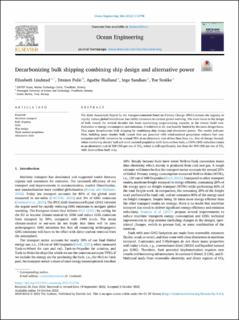| dc.contributor.author | Lindstad, Elizabeth | |
| dc.contributor.author | Polic, Drazen | |
| dc.contributor.author | Rialland, Agathe Isabelle | |
| dc.contributor.author | Sandaas, Inge | |
| dc.contributor.author | Stokke, Tor | |
| dc.date.accessioned | 2022-11-30T09:59:03Z | |
| dc.date.available | 2022-11-30T09:59:03Z | |
| dc.date.created | 2022-10-28T08:53:02Z | |
| dc.date.issued | 2022 | |
| dc.identifier.citation | Ocean Engineering. 2022, 266 (2), 1-11. | en_US |
| dc.identifier.issn | 0029-8018 | |
| dc.identifier.uri | https://hdl.handle.net/11250/3034961 | |
| dc.description.abstract | The Sixth Assessment Report by the Intergovernmental Panel on Climate Change (IPCC) stresses the urgency to rapidly reduce global Greenhouse Gas (GHG) emissions to contain global warming. The main focus in the design of bulk vessels for several decades has been maximizing cargo-carrying capacity at the lowest build cost. Reduction in energy consumption and emissions, if achieved at all, was heavily limited by the main design focus. This paper decarbonizes bulk shipping by combining ship design and alternative power. The results indicate: First, building more slender bulk vessels that are powered with wind-assisted propulsion reduces fuel consumption and GHG emissions by around 25% at an abatement cost of less than Zero, i.e., free of charge; Second, when combining slender hull and wind-assisted propulsion with Zero-carbon fuels, a 100% GHG reduction comes at an abatement cost of 328 USD per ton of CO2, which is still significantly less than the 459 USD per ton of CO2 with Zero-carbon fuels only. | |
| dc.language.iso | eng | en_US |
| dc.publisher | Elsevier | en_US |
| dc.rights | Navngivelse 4.0 Internasjonal | * |
| dc.rights.uri | http://creativecommons.org/licenses/by/4.0/deed.no | * |
| dc.subject | Alternative fuels | en_US |
| dc.subject | Wind assisted propulsion | en_US |
| dc.subject | Ship design | en_US |
| dc.subject | GHG | en_US |
| dc.subject | Bulk shipping | en_US |
| dc.subject | Maritime transport | en_US |
| dc.title | Decarbonizing bulk shipping combining ship design and alternative power | en_US |
| dc.title.alternative | Decarbonizing bulk shipping combining ship design and alternative power | en_US |
| dc.type | Peer reviewed | en_US |
| dc.type | Journal article | en_US |
| dc.description.version | publishedVersion | en_US |
| dc.rights.holder | © 2022 The Authors. Published by Elsevier Ltd. | en_US |
| dc.source.pagenumber | 11 | en_US |
| dc.source.volume | 266 | en_US |
| dc.source.journal | Ocean Engineering | en_US |
| dc.source.issue | 2 | en_US |
| dc.identifier.doi | 10.1016/j.oceaneng.2022.112798 | |
| dc.identifier.cristin | 2065885 | |
| dc.relation.project | Norges forskningsråd: 237917 | en_US |
| dc.relation.project | Norges forskningsråd: 294717 | en_US |
| cristin.ispublished | true | |
| cristin.fulltext | original | |
| cristin.qualitycode | 1 | |

